There’s nothing like standing next to a real-life Dolmen Gate to inspire thoughts on how Magic settings treat the past.
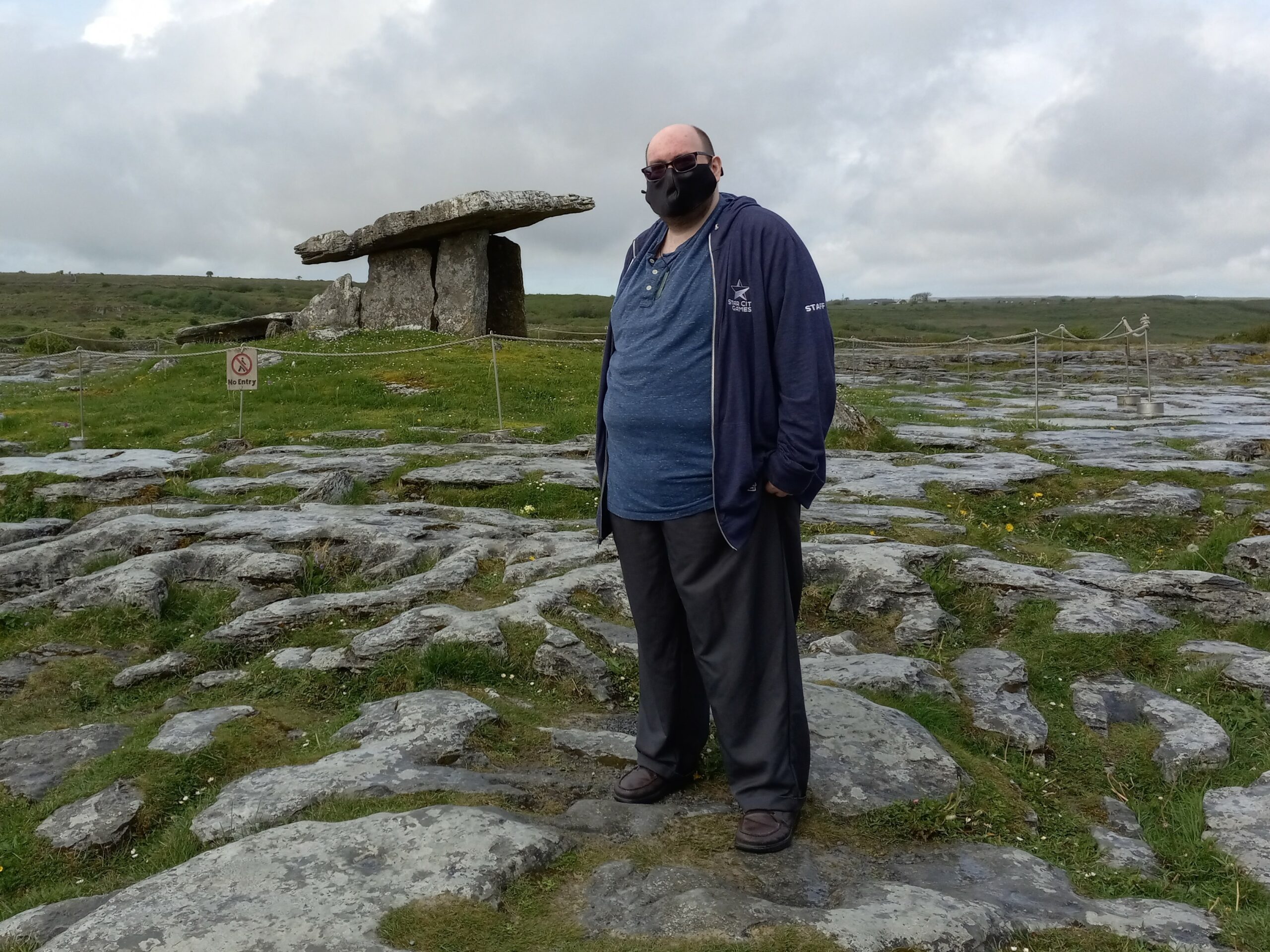
The author at Poulnabrone Dolmen, The Burren, County Clare, Ireland. Photograph by Kieran Cathcart of Tour Dublin.
This past May, I fulfilled a promise to take my mother to Ireland. In our week there, we saw millennia worth of history, from the five-millennia-old monumental tomb of Newgrange to the medieval ruins of Glendalough and 1950s filming locations for The Quiet Man in Cong. The place I felt most deeply, however, was Monasterboice, a small site in County Louth whose history in Christianity dates back some fifteen centuries.
The site has risen and fallen over the years. It has stone ruins of two late-medieval stone churches, a high-medieval round tower, and three high crosses, masterworks of medieval Celtic stone-carving depicting Biblical scenes, including Muiredach’s High Cross, still legible after over a millennium outdoors. A present thrives alongside the past: a modest Roman Catholic parish‘s cemetery, with burials ranging from the eighteenth century to the day I visited.
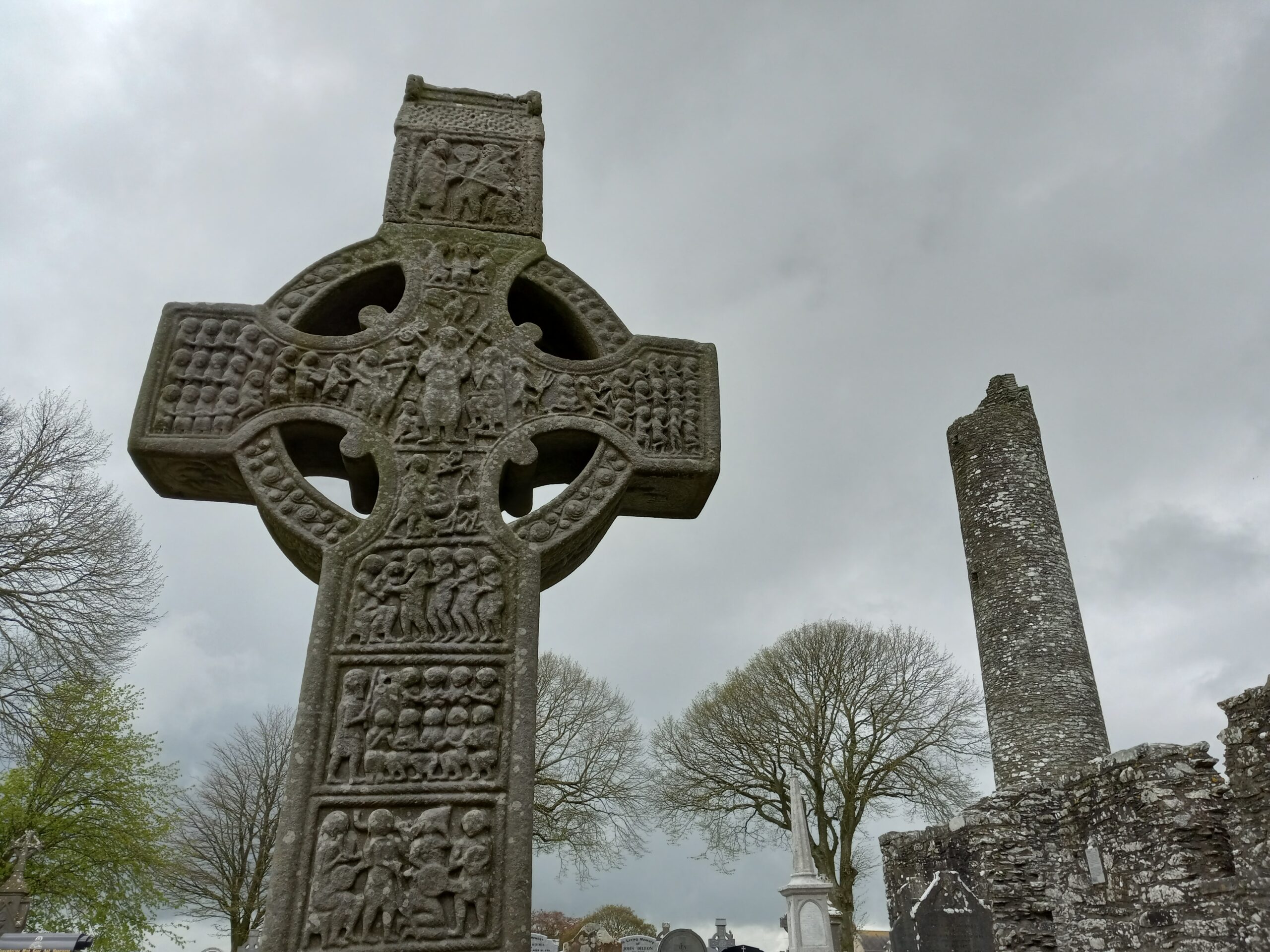
Elements of Monasterboice: Muiredach’s High Cross, round tower, stone church walls, modern grave markers. Photograph by the author.
Three Attitudes Toward the Past
Monasterboice honors the past by embracing it, preserving it by making it part of the community.
Similarly, in Magic: The Gathering settings, “embrace” is one of three stable attitudes toward the past that predominate.
One can create a triangular map of sorts, with embrace as the corner where knowledge of history and reverence for its artifacts meet. The opposite of embracing the past is showing it hostility, which forms a second corner. The third corner, ignorance, is itself the opposite of the knowledge inherent in both hostility and embrace. Ignorance lies midway between embrace and hostility; it’s hard to love or hate what one does not know exists.
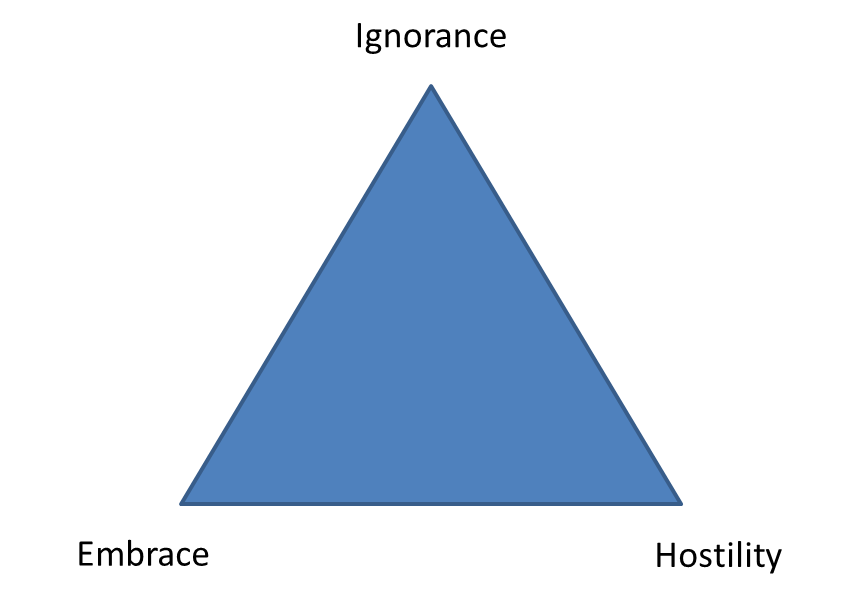
Image by Donny Caltrider.
These attitudes are rarely pure within a setting. Individuals may be indifferent to the past, dimly aware of it but caught up in the day-to-day. (On a setting-wide scale, indifference is an unstable attitude, usually sliding into ignorance as artifacts are lost through heedlessness.) Often, a faction will run counter to the prevailing attitude, such as the Gruul embracing the natural past on the city-plane of Ravnica. There may also be splits between a setting’s masses and its elite. Even so, knowing a setting’s general attitude toward the past is useful for understanding the setting’s overall spirit.
Embrace: Dominaria, the “History Plane”
Dominaria was the setting for most Magic: The Gathering sets in the game’s first decade, and it remains the most frequently visited plane. In 2018, with the release of the set also titled Dominaria, Wizards of the Coast gave what had previously been a catch-all plane its hook. Just as the original Mirrodin was “metal plane” and the original Ravnica was “city plane,” Dominaria became the “history plane,” deeply tied to its long and much-told past.
Even as early as October 2006, however, hints of the “history plane” abounded. The Time Spiral set was full of references and callbacks, such as Saffi Eriksdotter, previously only a “last words” victim in the flavor text of Lhurgoyf, becoming her own tournament-winning card.
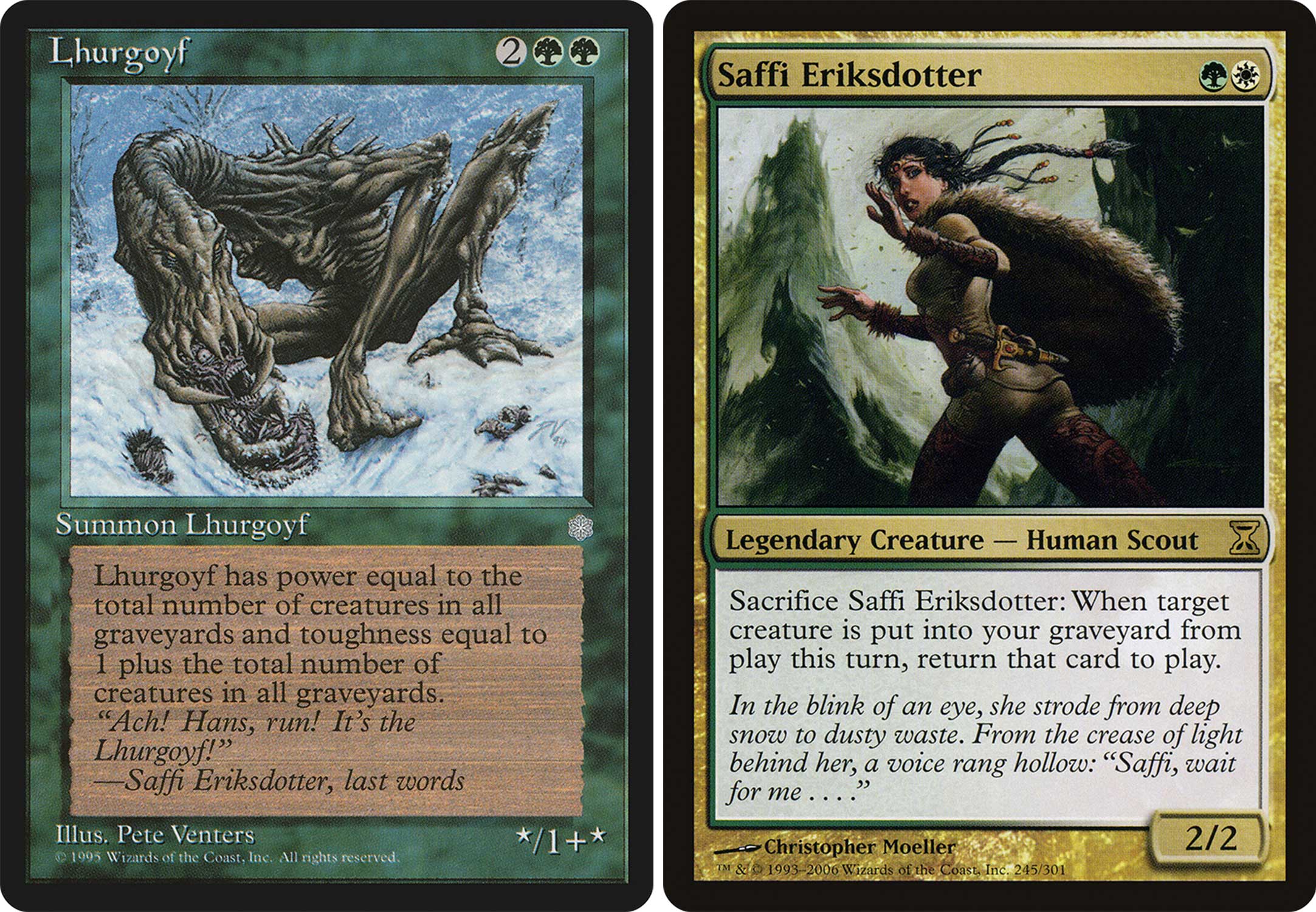
Other signifiers abound in the post-Dominaria sets. King Darien XLVIII (that’s 48 in Arabic numerals) attests to the sheer number of generations of rule in New Argive, putting even Sweden’s numbers to shame. The stained-glass armor of Benalia, as seen on Guardian of New Benalia, evokes the beauty of centuries-old stained glass in real-world churches and cathedrals.
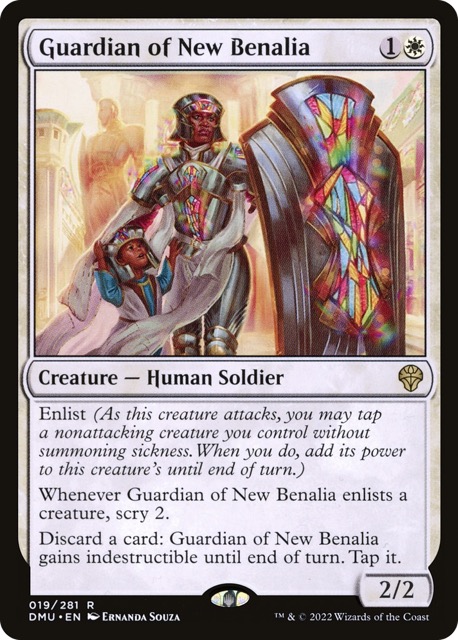
Despite being invaded by Phyrexians twice and an assortment of other calamities — the Sylex Blast at the end of the Brothers’ War was the fantasy equivalent of nuclear winter — Dominaria and its embrace of the past will endure. We just don’t know the details yet.
Hostility: Kaladesh, the “Progress Plane”
By contrast, the plane of Kaladesh showed overall hostility to the past in its first three appearances, as one of several settings for Magic Origins and then alone in Kaladesh and Aether Revolt. A Scryfall Lore Finder search in Kaladesh block reveals zero instances of “history” and only one of “past,” with even that instance, on Trophy Mage, focusing on using the past rather than honoring it. Its few monuments to past figures, such as those depicted on Inspiring Statuary and described in the story “In the Dead of Night,” are of inventors, makers of the future.
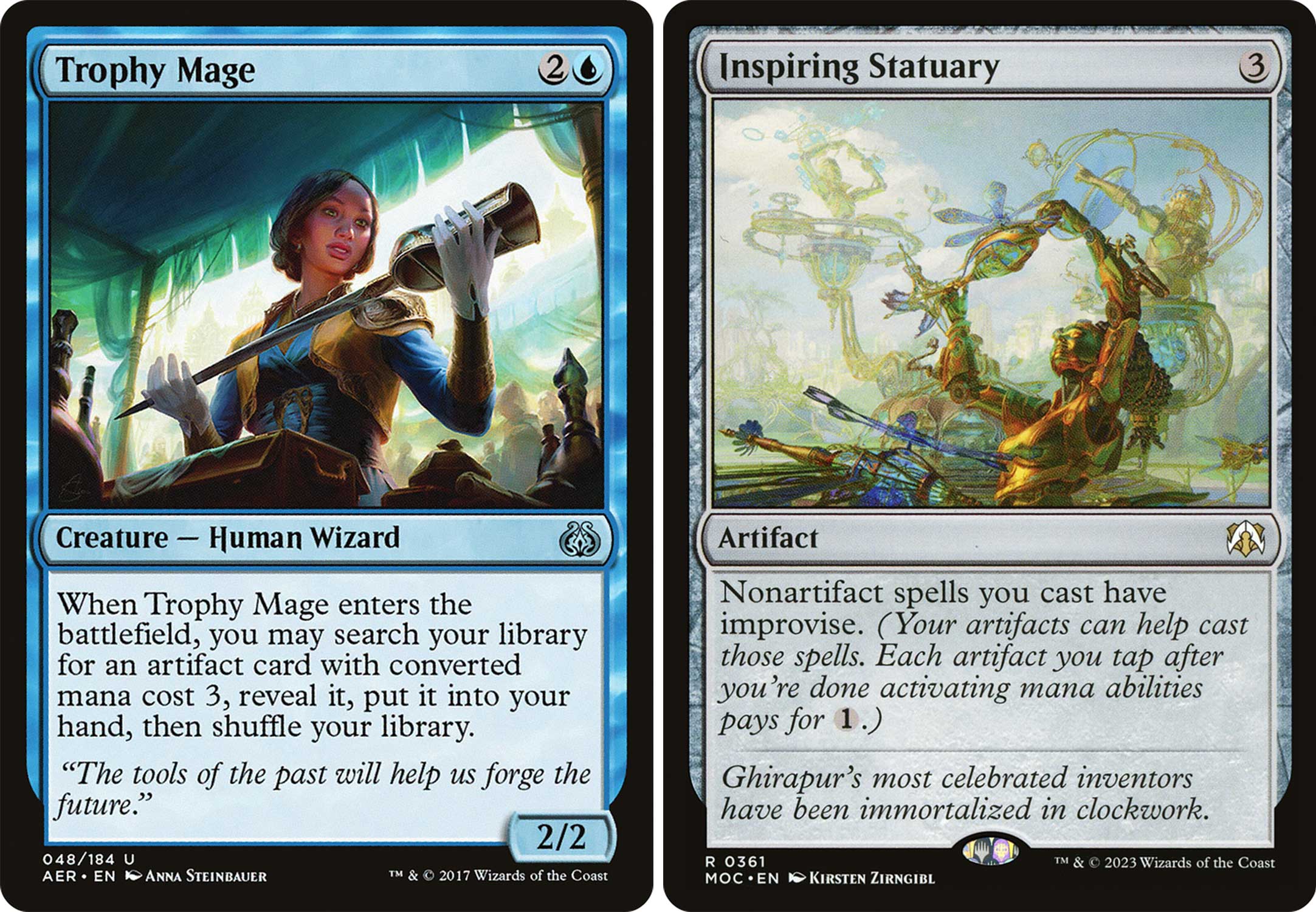
In Chandra’s origin story, “Fire Logic,” magic itself is an aspect of the past that the ruling Consulate wishes to eliminate. As then-Captain Baral, a character I’ve written about before, tells his subordinate:
“This is not about a couple of fugitives, soldier,” said the captain, not raising his voice above an even whisper. “It’s about the future. We need to show the people of this city that we’re prepared to move beyond the barbaric age of the past, to embrace progress. The girl is a remnant of a chaotic time. An obstacle. If we’re going to move forward, we’ll need our path to be clear. The consuls will understand that.”
Kaladesh does have its pockets of revering the past: both the natural past, as seen on Greenbelt Rampager and Sage of Shaila’s Claim, and the historical-personal past, as seen on Lost Legacy. Even so, Kaladesh still reads as a “place of now” — and with the necessary rebuilding after the events of March of the Machine, it will read even more so.
Ignorance: Grixis, the (Former) “Dying Plane”
Before “Grixis” was shorthand for a deck containing Blue, Black, and Red, it was one of the Shards of Alara before the Conflux reunited the plane. Cut off from white and green mana, order and nature, it was a hellscape of necromancer warlords and their undead armies, demons, cursed ogres, and a handful of humans like the Vithians trying to cling to something like a community.
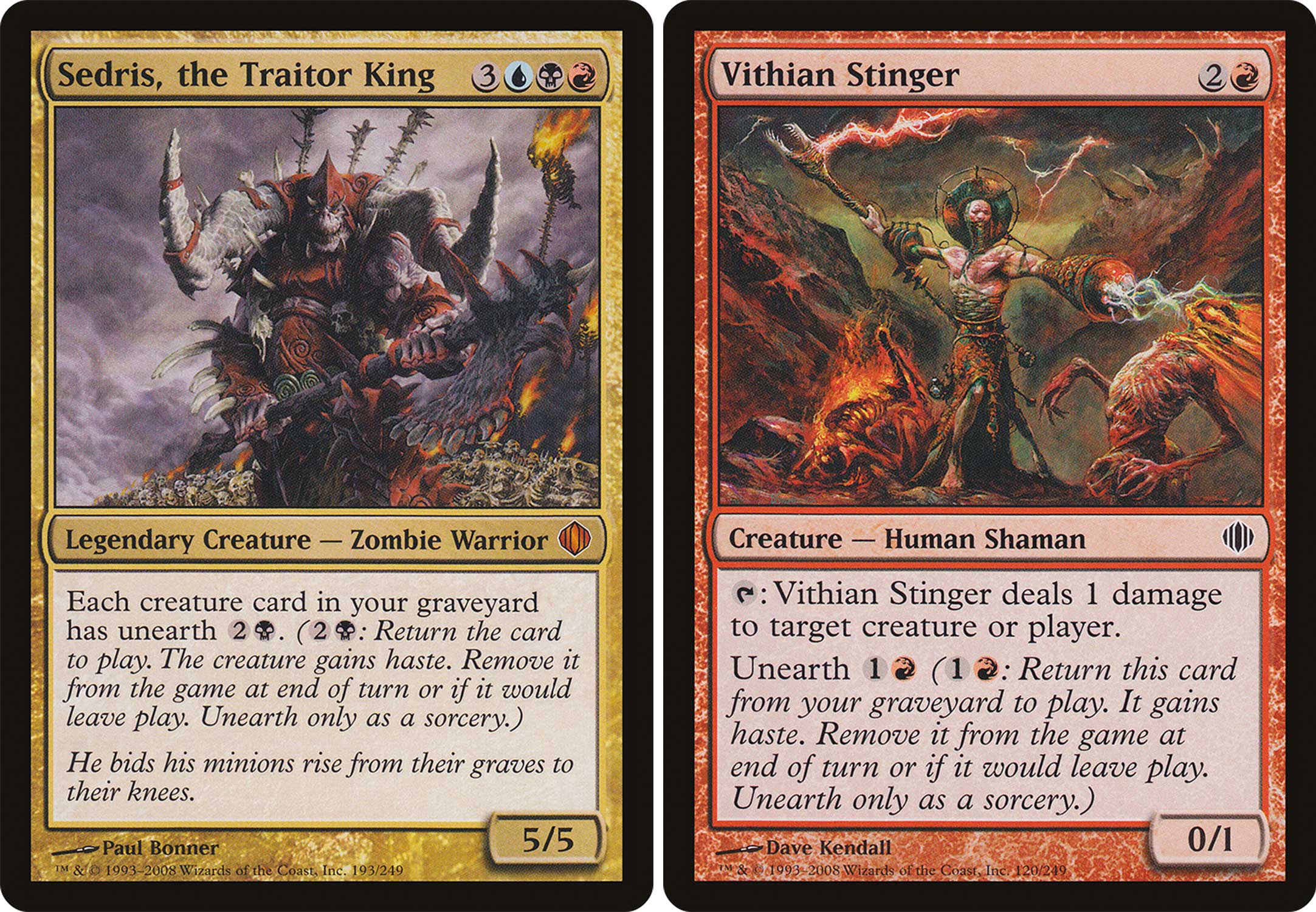
The ignorance of Grixis is one of precarity. When a plane itself is dying and every living being must scrap and scramble for survival, what good is the past? Never mind what kings once walked the ruin; it offers shelter now. Take what you can and use it before someone tries to take it from you.
Hostile Elite(s), Ignorant Populace
The ignorance of Grixis is, ironically for a dying plane, organic. There is another type of ignorance, imposed by a history-hostile elite among the people, that recurs surprisingly often in Magic lore.
Amonkhet
The most blatant example of this history suppression by the elite is Amonkhet. As recounted in “The Hour of Revelation,” Nicol Bolas descended upon the plane and cast a single spell, “and every mortal old enough to walk dissipated into the sky.” He turned the Gods of Amonkhet to his own ends, gave the lost and squalling infants of the plane mummy caretakers, and reshaped the old lore to create a plane-wide doomsday cult dedicated to creating elite undead champions for the God-Pharaoh’s future army.
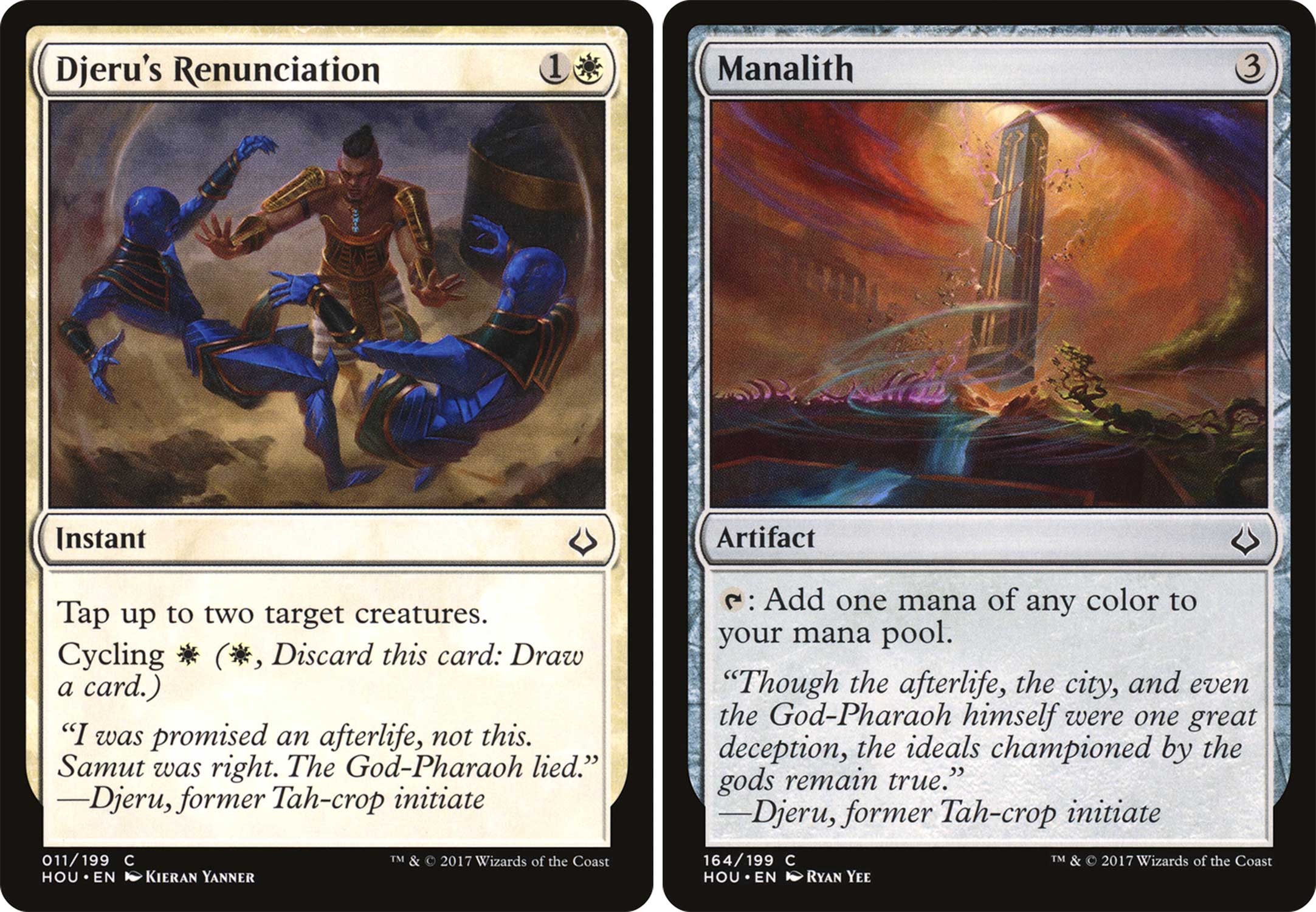
Amonkhet was still reeling from the revelations and devastation of Bolas’s plans when the Phyrexians invaded. Whether Amonkhet will recover enough to create a past worth remembering remains an open question.
New Capenna
A (slightly) more benevolent case is that of New Capenna. As seen at the beginning of the set Streets of New Capenna, the city of New Capenna is a bubble of civilization protected by a magical barrier consisting of the Angel-stuff Halo, much how the settlement of Naktamun on Amonkhet had the magical barrier of the Hekma. That barrier, however, was the fruit of a most poisonous tree: the Demons of New Capenna, creators of its ruling crime families, backstabbed the Angels who had so heroically defended the plane, binding them and draining their essence to produce Halo in a crime long forgotten.
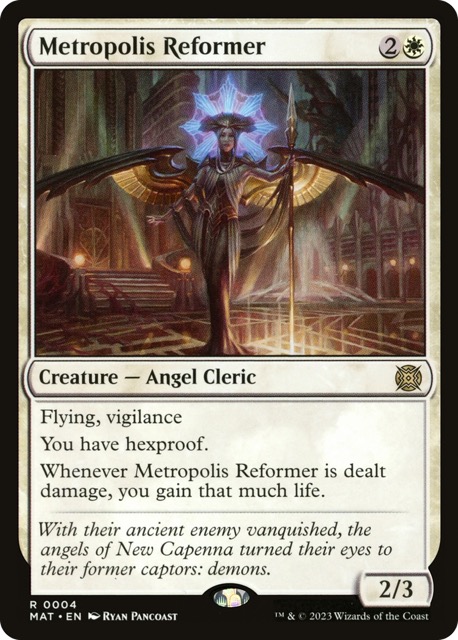
Life in New Capenna (pre-New Phyrexian invasion, anyway) was better than a death cult for the vast majority, and for a few, an Art Deco-inspired high life awaited. But with Park Heights literally brought crashing down to save the rest of the city and a looming war between the Angels and the Demons, New Capenna’s future is far from certain.
Lorwyn / Shadowmoor
Just as New Capenna is linked to Amonkhet through its bubble setting, it has a link to yet another example of the hostile elite-ignorant populace dynamic, the former Lorwyn / Shadowmoor, through the hideaway mechanic.
Before the events of Lorwyn and Shadowmoor blocks, the plane had two forms. Lorwyn, the “day” form, was a fairy-tale, almost twee place of communal Kithkin, cheery Merfolk, and ornery Goblins, with only the haughty Elves bringing a discordant note. Shadowmoor, the “night” form, was the opposite, with humble Elves striving against a hostile, paranoid, and bitter world.
One of the few beings to retain memories of both Lorwyn and Shadowmoor, and the motive force behind the Great Aurora that flipped the plane, was Oona, Queen of the Fae.
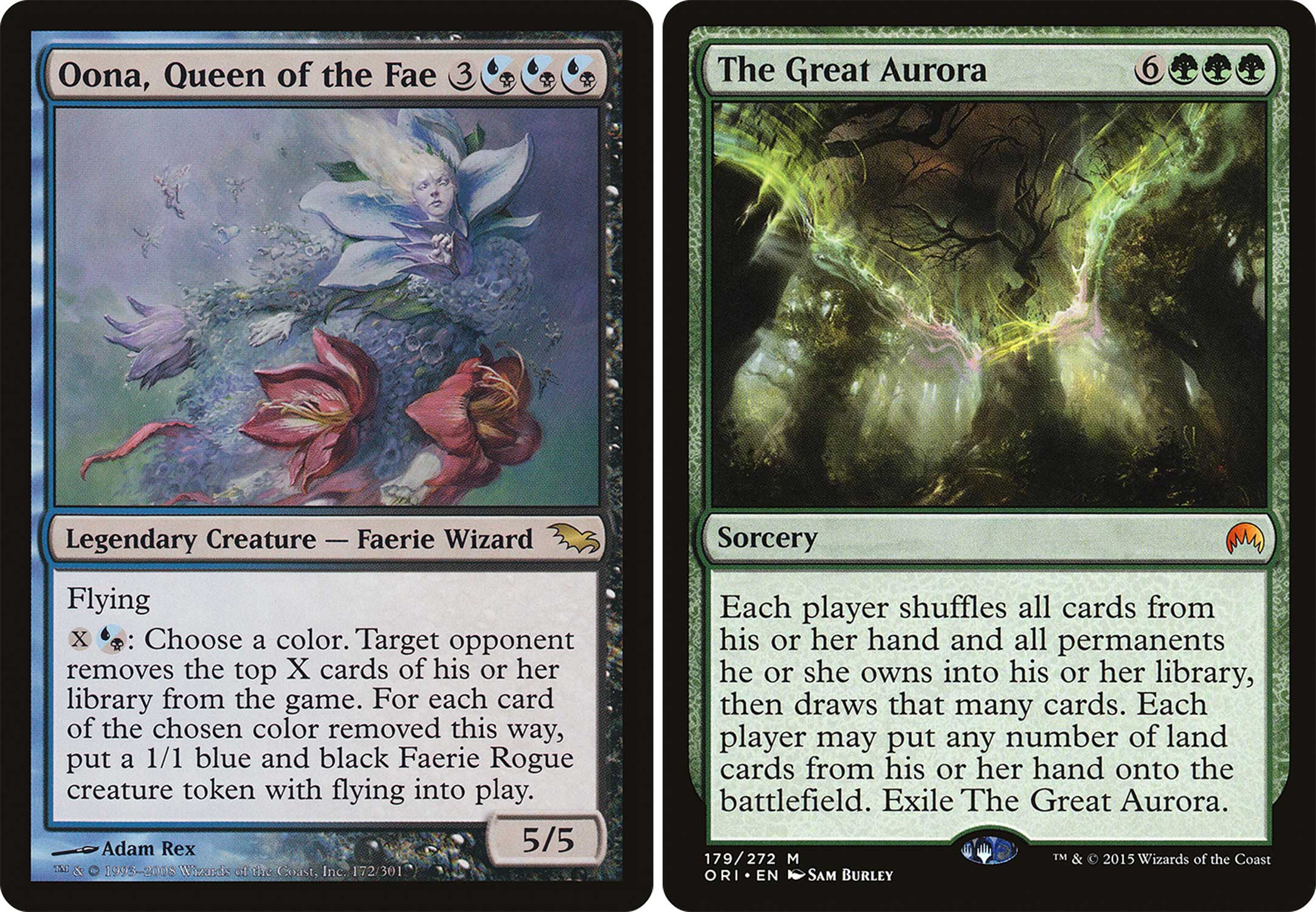
For it was Oona who had lengthened Lorwyn-Shadowmoor’s days and nights to last centuries at a time. She knew what was coming, and how to use it to stay a dominant force on the plane. Who but she and her closest Faerie associates knew that Spinerock Knoll was the Knollspine Dragon sleeping?
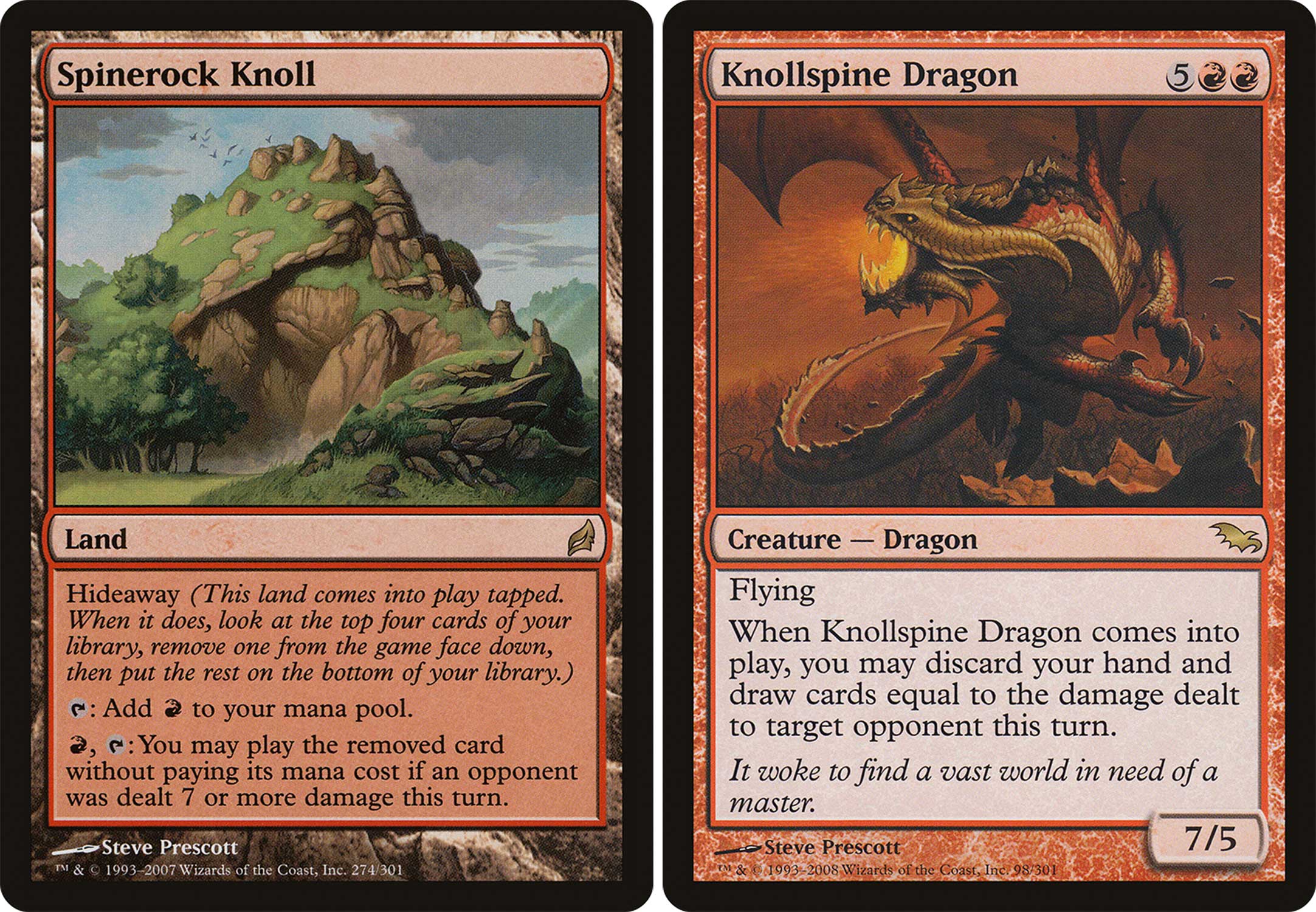
The final Great Aurora and the events of the Eventide set broke Oona’s power over Lorwyn-Shadowmoor, and the renewed Lorwyn (as seen on Invasion of Lorwyn) has regular days and nights. Its present attitude toward the past, however, remains a mystery.
Future Pasts
The next great puzzle of attitudes toward the past is how various planes incorporate or reject their New Phyrexian invasions. For example, will the broken-down court system of Wilds of Eldraine find a role in its plane’s new tapestry or face oblivion? After that, what role will the past play when the Lorehold alumnus Quintorius starts exploring the Lost Caverns of Ixalan?
Both set names suggest they will take place in the margins, but history is a cloak seldom shrugged completely, and the recent past least of all. Bring on the future!

